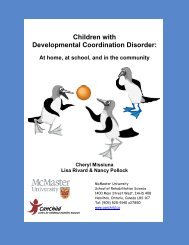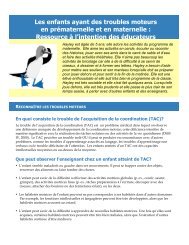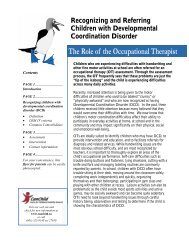PrePrinting and Fine Motor Skills â Lunch & Learn Goals ... - CanChild
PrePrinting and Fine Motor Skills â Lunch & Learn Goals ... - CanChild
PrePrinting and Fine Motor Skills â Lunch & Learn Goals ... - CanChild
Create successful ePaper yourself
Turn your PDF publications into a flip-book with our unique Google optimized e-Paper software.
GET A GRIP!O.T. TIPS FOR PROPER PENCIL GRASPWhy care about pencil grasp? Incorrect grasps can strain muscles <strong>and</strong> lead to fatigue <strong>and</strong> reduced endurance forwriting Some grasp patterns can put finger joints at risk for damage over the long term Some grasps impede the development of legible <strong>and</strong> efficient h<strong>and</strong>writing Pencil use requires the use of the “skilled side of the h<strong>and</strong>”- thumb, finger <strong>and</strong> middlefingers. These are the same fingers we need to complete many daily tasks(fastening/unfastening buttons <strong>and</strong> zippers, using eating utensils, opening containers,using the computer mouse).Typical development of grasp:Although the dynamic tripod grasp is often cited as the best or most mature grasp, a quadrapodor thumb <strong>and</strong> three finger grasp <strong>and</strong> a lateral tripod grasp (thumb on the pointer finger ratherthan the pencil) have been shown to be just as good. A more important factor is if the graspallows for dynamic finger movements versus the movement having to come from the whole arm.How can we help the child develop a mature grasp pattern? Involve the child in lots of play activities that use tools <strong>and</strong> materials other than pencil<strong>and</strong> paper. For example, scissor skills are a great precursor to pencil grasp. Activities todevelop in-h<strong>and</strong> manipulation are also helpful. As the child develops better fine motor control, start them with small pieces of chalk orcrayon (1.5 – 2 inches) to encourage them to use their thumb <strong>and</strong> first two fingers only. Where possible, have them work on a vertical surface, e.g., easel or chalkboard. Thisencourages the correct grasp <strong>and</strong> wrist position. Focus on drawing first so they learn to make the basic lines <strong>and</strong> shapes <strong>and</strong> to be ableto start <strong>and</strong> stop the crayon while using a relaxed but controlled graspl ― O † ⁄ □ \ X Δ Once they have at least a static tripod grasp, they are ready to start to use a pencil.© Developed by the Partnering for Change team, <strong>CanChild</strong>, McMaster University, 2013 Page 1 of 2







